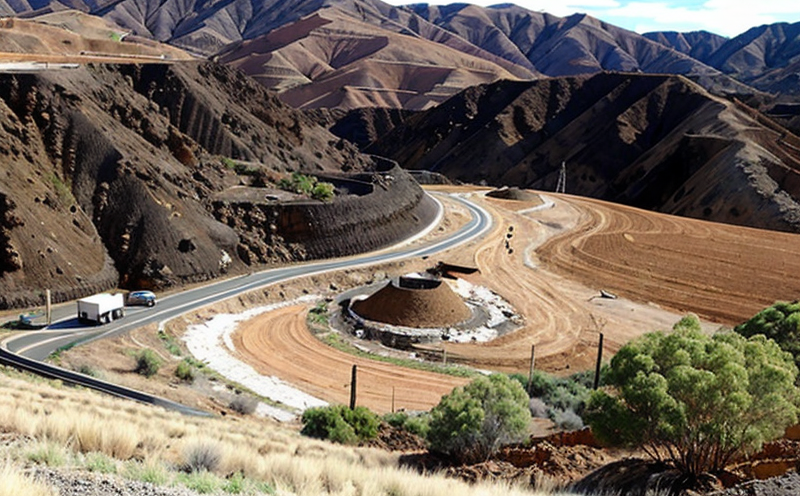ASTM D2167 Soil Density Testing of Restored Land
The process outlined in ASTM D2167 is specifically designed to determine the density of compacted soil, which plays a crucial role in assessing the stability and suitability of restored land for mining operations. This service ensures that the reclamation efforts comply with environmental regulations and contribute positively to sustainability goals.
Soil density testing is essential during various phases of mine rehabilitation, including site preparation, construction, and post-construction monitoring. The test measures the degree to which soil particles are packed together or compacted. A higher soil density indicates a tighter packing of soil particles, resulting in lower porosity and better strength properties.
When conducting ASTM D2167 tests on restored land, it is important to ensure that the sample preparation methods adhere strictly to the standard’s requirements. This includes ensuring that the soil is representative of the site being tested, as any bias can lead to inaccurate results. The use of proper sampling techniques and equipment minimizes errors during testing.
The significance of this test lies in its ability to provide critical data for decision-making processes related to land reclamation projects. By accurately determining the density of compacted soil, stakeholders involved in mining operations can make informed decisions about further treatment or stabilization efforts. This ensures that reclaimed lands are safe and capable of supporting intended uses.
Environmental considerations play a vital role when performing ASTM D2167 tests on restored land. The aim is not only to meet regulatory requirements but also to promote ecological balance by ensuring that the soil's physical properties support plant growth and overall ecosystem health. Properly conducted density tests help identify areas where additional intervention might be necessary for successful reclamation.
For those responsible for quality management, compliance officers, R&D engineers, or procurement personnel overseeing these types of projects, understanding ASTM D2167 is key to ensuring regulatory compliance and achieving desired outcomes from land rehabilitation efforts. Accurate soil density testing provides valuable insights into the effectiveness of reclamation strategies while promoting sustainable practices.
In summary, ASTM D2167 soil density testing serves as an important tool for evaluating the quality of reclaimed land in mining operations. Its application ensures that all phases of a project—from initial site preparation through post-construction monitoring—are conducted according to best practices recognized by industry standards like this one.
Applied Standards
| Standard | Description |
|---|---|
| ASTM D2167-18 | Standard Test Method for Compaction of Soils in Small Standard Cylinders Using a Vibratory Roller |
| American Society for Testing and Materials (ASTM) | International standards organization responsible for developing technical standards used across various industries. |
The application of ASTM D2167 ensures consistency in testing procedures, which is essential for accurate measurement and reliable results. Compliance with these standards guarantees that all parties involved have confidence in the integrity of the data obtained during soil density tests on restored land.
Scope and Methodology
| Aspect | Description |
|---|---|
| Testing Procedure | The procedure involves compacting soil in a standard cylinder using a vibratory roller and then measuring the dry unit weight (weight per unit volume) of the compacted soil. |
| Sampling | A representative sample must be collected from the area being tested to ensure that the test reflects actual conditions accurately. Samples should be taken across different depths if necessary. |
Conducting ASTM D2167 tests requires precise sampling and compacting techniques, along with careful measurement of dry unit weights. These steps are critical for obtaining reliable results that can guide decisions regarding the success of reclamation efforts.
The methodology outlined in ASTM D2167 ensures consistency across multiple sites and projects by providing clear instructions on how to perform soil density tests. This standard helps maintain high-quality standards while ensuring that all testing is conducted uniformly.
Environmental and Sustainability Contributions of ASTM D2167 Soil Density Testing in Mining Operations
The use of ASTM D2167 soil density testing contributes significantly to environmental sustainability goals within the mining sector. By accurately assessing the compacted state of soil during reclamation processes, this test helps ensure that restored lands meet both regulatory requirements and ecological objectives.
One key benefit is improved land stability, which reduces the risk of erosion or landslides after reclamation. Ensuring proper soil density through ASTM D2167 tests supports long-term sustainability by creating more resilient landscapes capable of supporting diverse vegetation and wildlife.
In addition to enhancing natural ecosystems, adhering to ASTM D2167 standards promotes responsible resource management practices that minimize negative impacts on surrounding environments. These efforts help create safer working conditions for miners while contributing positively to local communities’ well-being.
By integrating ASTM D2167 soil density testing into their operations, mining companies demonstrate commitment to environmental stewardship and sustainable development principles. This approach aligns with broader industry trends towards greener practices and responsible resource utilization.





